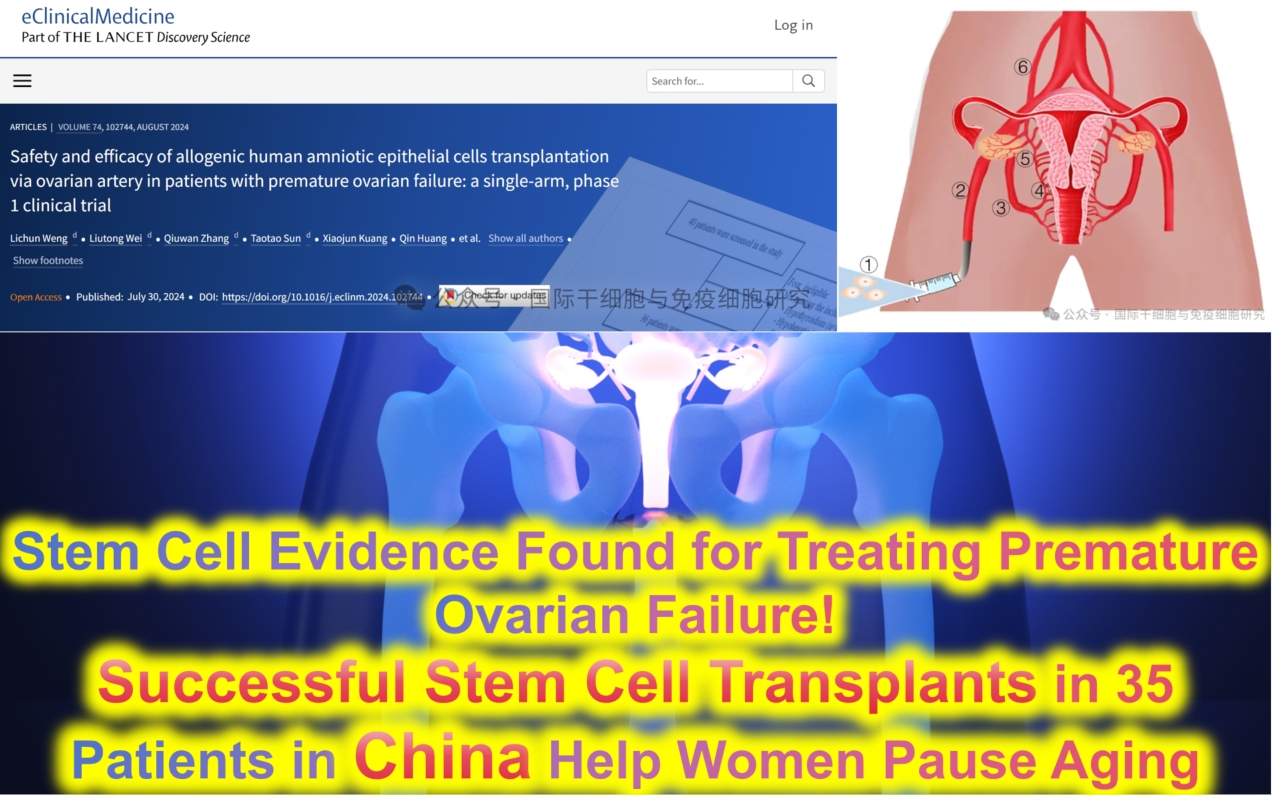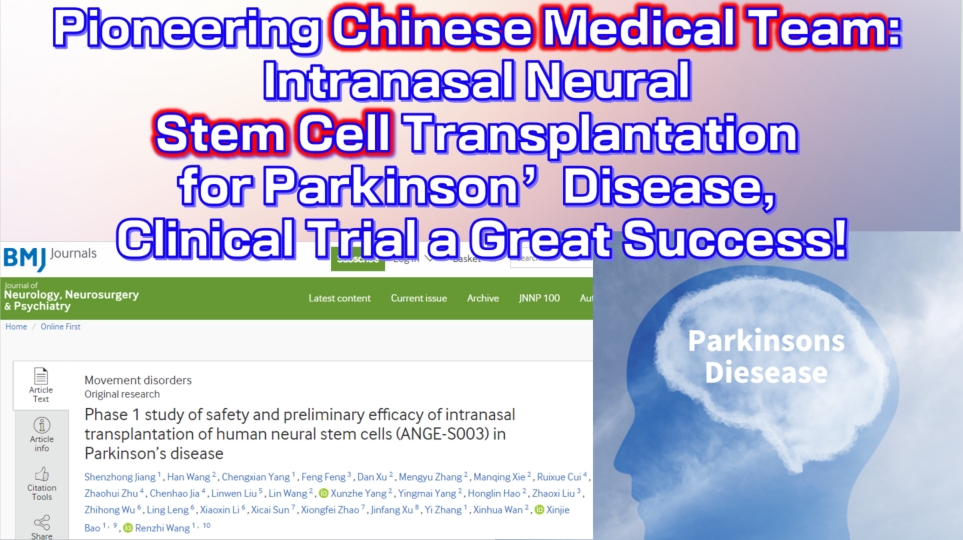Warning: Trying to access array offset on value of type bool in /www/wwwroot/www.medtourcn.com/wp-content/themes/medical-directory/framework/theme/medicaldirectory-image.php on line 78
Warning: Trying to access array offset on value of type bool in /www/wwwroot/www.medtourcn.com/wp-content/themes/medical-directory/framework/theme/medicaldirectory-image.php on line 79

Stem Cell Evidence Found for Treating Premature Ovarian Failure! Successful Stem Cell Transplants in 35 Patients in China Help Women Pause Aging
Stem Cell Evidence Found for Treating Premature Ovarian Failure!
Successful Stem Cell Transplants in 35 Patients in China Help Women Pause Aging

Stem Cell
As women age, not only does their appearance age, but important organs like the ovaries and uterus also gradually deteriorate. The ovaries, considered the “pacemaker” of female aging, play a crucial role in regulating menstruation and producing sex hormones. However, they often age faster than other body organs, which can accelerate overall aging. Therefore, anti-aging for women should not be superficial; it is crucial to focus on ovarian health and address premature ovarian failure (POF) promptly, helping women hit the “pause button” on aging!
Stem cells, as a cutting-edge medical technology, offer a glimmer of hope in delaying aging for women. A recent Phase I clinical study in China on “Allogeneic Stem Cell Transplantation for Treating Premature Ovarian Failure” has once again confirmed the feasibility of stem cell therapy, offering new hope and options for POF patients!
**Understanding Premature Ovarian Failure (POF)**
Premature ovarian failure, also known as “premature menopause” or “primary ovarian insufficiency,” is a progressive condition characterized by declining ovarian function. It is primarily caused by factors such as environmental influences, autoimmune diseases, and genetic defects, leading to the premature depletion of the ovarian follicle pool.
POF typically affects women under the age of 40. Globally, about 3.5% of women suffer from this condition. Common symptoms include irregular menstruation or amenorrhea, decreased estradiol (E2) levels, and elevated serum follicle-stimulating hormone (FSH) levels.
**Diagnostic Criteria for POF**
The “Chinese Society of Obstetrics and Gynecology” defines the diagnostic criteria for POF as follows:
-
Oligomenorrhea or amenorrhea lasting at least 4-6 months.
-
Two consecutive FSH levels >40 U/L, measured at least four weeks apart.
-
Decreased estrogen levels accompanied by menopausal symptoms.
**The Impact of Premature Ovarian Failure**
POF significantly affects women’s health, causing not only premature aging of the ovaries but also potentially accelerating the aging of multiple tissues and organs. The main impacts include:
-
Symptoms such as vaginal itching, dryness, and discomfort.
-
The potential for amenorrhea, lack of mature follicles, and low estrogen levels, significantly reducing the likelihood of natural conception.
-
Increased risk of osteoporosis, cardiovascular diseases, and cognitive impairment, necessitating serious attention from women.
**Traditional Treatments for POF and Their Limitations**
POF is a challenging condition to treat. Hormone replacement therapy (HRT) is currently the main treatment, helping prevent the adverse effects of prolonged estrogen deficiency, such as alleviating menopausal symptoms, protecting bone health, and reducing the risk of cardiovascular disease. However, long-term HRT use has two major drawbacks:
-
HRT can cause side effects such as nausea, headaches, and endometrial hyperplasia.
-
Long-term HRT use may increase the risk of thromboembolism, breast cancer, ovarian cancer, and dementia.
Hence, new treatments are urgently needed to replace HRT. Recent research indicates that stem cell therapy has broad potential in treating POF, helping alleviate menopausal symptoms, improve ovarian function, and enhance patients’ quality of life. The main methods include intravenous infusion, laparoscopic surgery, transvaginal ultrasound-guided surgery, and ovarian artery transplantation (using super-selective catheterization from the uterine artery to the ovarian branch) for stem cell transplantation to treat POF.
**Successful Completion of Phase I Clinical Study on hAEC Treatment for POF in China**
Recently, China conducted a Phase I clinical study (NCT02912104) on “Application of Human Amniotic Epithelial Cells (hAEC) in Treating Premature Ovarian Failure (POF),” enrolling 35 POF patients with evaluable efficacy. The average age of participants was 34.57 years (ranging from 18 to 45 years), with an average duration of amenorrhea of 4.71 years. Among them, 91.43% (32 patients) had previously received continuous or intermittent HRT, while 8.57% (3 patients) had not received HRT for at least one year.
**Stem Cell Treatment Process for POF**
After enrollment, the patients received human amniotic epithelial cell (hAEC) infusion via the ovarian artery. The average treatment duration was 53.4 minutes, with the majority (94.29%) of patients discharged within 24 hours. The main treatment steps were as follows:
-
The doctor performed arterial puncture in the right femoral artery.
-
A catheter was then inserted into the uterine artery.
-
Super-selective catheterization was performed on the ovarian branch of the uterine artery.
-
Finally, human amniotic epithelial cells (hAEC) were slowly injected along the microcatheter to ensure precise delivery to the treatment site.
**Clinical Study Results Analysis**
Follow-up evaluations were conducted at different time points after hAEC stem cell transplantation [1 month (V-1), 3 months (V-2), and 5 months (V-3)], showing significant improvements in endometrial thickness, hormone levels, ovarian size, and menopausal symptoms, with good safety. Specific findings include:
**Menstrual Bleeding Recovery**
Compared to five months before treatment, the average number of spontaneous menstrual bleeding episodes significantly increased after stem cell transplantation. Specifically, 37.14% of patients (13/35) experienced at least one episode of spontaneous menstrual bleeding post-treatment (Figure a), and 20.00% (7/35) had more than one episode of regular menstrual bleeding (Figure b).
**Endometrial Thickness**
Follow-up results showed a significant increase in endometrial thickness one month (V-1) and five months (V-3) after stem cell transplantation.
**Ovarian Size**
One month (V-1) after stem cell transplantation, observations showed a significant increase in the size of the left ovary (p=0.041).
**Hormone Levels**
POF patients often experience decreased estradiol (E2) levels and elevated serum FSH levels. However, these hormone levels significantly improved after hAEC stem cell transplantation.
-
**FSH Decrease**: FSH levels showed a downward trend after treatment, with statistically significant differences observed five months (V-3) post-transplantation.
-
**Estradiol (E2) Increase**: Follow-up evaluations one month (V-1) and five months (V-3) after stem cell transplantation revealed significant increases in E2 levels.
**Menopausal Symptoms**
Assessed using the Menopause-Specific Quality of Life Questionnaire (MENQOL), the main changes were as follows:
-
**Overall MENQOL Score**: The overall MENQOL score before treatment (V-0, baseline before hAEC treatment) was 8.74-13.48. Post-treatment, the score significantly decreased to 7.57-10.42 (V1, one month post-stem cell transplantation), 7.28-11.46 (V2, three months post-stem cell transplantation), and 6.85-9.58 (V3, five months post-stem cell transplantation).
-
**Physical Symptoms**: Compared to before treatment, physical symptoms significantly improved post-stem cell treatment, with scores of 1.45-2.27 (V-1), 1.30-2.31 (V-2, three months post-stem cell transplantation), and 1.31-1.98 (V-3, five months post-stem cell transplantation).
-
**Sexual Function**: The sexual function score before stem cell treatment was 2.77-4.75. Post-treatment, there were significant improvements, with scores of 1.90-3.97 (V-2, three months post-stem cell transplantation) and 1.47-3.32 (V-3, five months post-stem cell transplantation).
**Good Safety Profile**
The study found that hAEC transplantation only caused mild adverse reactions, such as hematoma, fever, and pelvic pain, which mostly resolved on their own, with no serious adverse events reported. Notably, one patient who had previously failed in vitro fertilization-embryo transfer (IVF-ET) treatment successfully retrieved two oocytes two months after this stem cell transplantation. This indicates that the patient obtained two viable frozen embryos without any additional hormone or drug treatment!
🎉🎉To assess whether the condition is suitable for CAR-T or clinic therapy, you can submit Advanced Medicine in China for preliminary evaluation!
WhatsApp: +8613717959070
Email: doctor.huang@globecancer.com
#StemCellTherapy #PrematureOvarianFailure #AntiAging #WomenHealth #MedicalBreakthrough #OvarianHealth #RegenerativeMedicine
Warning: Trying to access array offset on value of type bool in /www/wwwroot/www.medtourcn.com/wp-content/themes/medical-directory/framework/theme/medicaldirectory-image.php on line 78
Warning: Trying to access array offset on value of type bool in /www/wwwroot/www.medtourcn.com/wp-content/themes/medical-directory/framework/theme/medicaldirectory-image.php on line 79

Pioneering Chinese Medical Team: Intranasal Neural Stem Cell Transplantation for Parkinson’s Disease, Clinical Trial a Great Success!
**Pioneering Chinese Medical Team: Intranasal Neural Stem Cell Transplantation for Parkinson’s Disease, Clinical Trial a Great Success!**

Parkinson’s Disease
**Breakthrough Research**
The expert team at Peking Union Medical College Hospital (PUMCH) has conducted the world’s first clinical trial (ANGE-S003) using intranasal human neural stem cell transplantation to treat Parkinson’s disease, yielding promising results and offering new hope to patients!
**Study Highlights**
In this study, 18 patients with advanced Parkinson’s disease (disease duration over 5 years) received four intranasal neural stem cell transplants. The results were impressive:
**Significant Improvement in Parkinson’s Disease Rating Scale Scores**:
By the 6th month of treatment, the MDS-UPDRS score decreased by an average of 19.9 points, showing the most significant improvement (p<0.001).
**No Serious Adverse Reactions**:
Post-treatment, no serious adverse reactions related to neural stem cells were observed, and brain MRI scans showed no tumor formation.
**Limitations of Traditional Parkinson’s Disease Treatments**
Current drug and surgical treatments cannot increase the number of dopamine neurons, resulting in limited efficacy. The innovative approach of using neural stem cells aims to address this issue.
**Neural Stem Cells: A Regenerative Hope**
Parkinson’s disease involves the loss of dopamine neurons. Neural stem cells can replace these lost neurons, controlling the disease progression at its root. PUMCH’s novel method of intranasal administration of neural stem cells marks a significant milestone in Parkinson’s disease treatment.
**Future Prospects**
